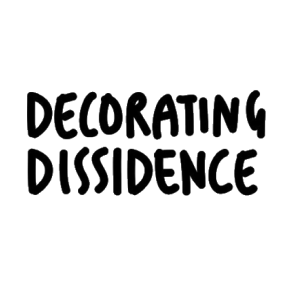Image: Loy Allen Bowlin, Ted Degener, 1990. Courtesy of SPACES–Saving and Preserving Arts and Cultural Environments.
This introduction is my open love letter to Glitter. Glitter sits between binaries of affect and experience: pleasure and repulsion, dazzling and subtle, tactile and ephemeral, quotidian and political, environmentally trepidatious and worldmaking. For this issue, Glitter is a catchall term to embody all of the various components of Glitter. It transcends names, being itself a verb and a noun: the glint of tinsel, the shine of foil, a wink on the curving surface of a pearl, and the passing cascade of reflections from a disco ball. Glitter is relational. It crosses temporalities and spatial configurations. Have you looked up at the night sky recently? Those stars, long dead for millions of years and they still shimmer.
Yet, in all its splendor, Glitter has not be “taken seriously.” Recent scholarship, such as Rebecca Coleman’s The Future Politics of a Ubiquitous Thing (2020) and Nicole Seymour’s Glitter (2022), have begun to consider how Glitter’s versatile use and presence is a form of worldmaking, protest, and potential. These conversations have pushed Glitter outside of its material constraints of being bits of reflective plastic. This issue of Decorating Dissidence is a means of continuing this expansion outward consider how Glitter conceptually embodies more than its material presence, particularly in its relationship to craft. Considering Glitter as a craft material opens our understanding of what craft can be and look like.
Glitter is, in many ways, a conduit of intimacy. Through its multi-present nature and relationality, Glitter brings individuals together. Artist Tavi Meraud captures this idea by considering the relationship of iridescence and intimacy in their article “Iridescence, Intimacies”. Iridescence – another coat that glitter dons – tantalizes one to experience its splendor on the surface that it rests. Meraud asks us to consider the potential that a surface has. The surface is where intimate connections begin.This connection, writes Meraud, starts when there is visual contact right before “touch, in the sense of blunt contact,” happens. In this moment of contact, one becomes enamored with the iridescent surface. The shimmering surface becomes a site “of dazzling encounter” that transcends the boundaries of the real. The encounter of shine is a way of moving forward, inward, backward, upward, and outward of experience with an intimacy that extends outside our physicality.

The contributors to this issue have engaged with Glitter in all of its vastness, beauty, and complications. matt lambert looks at the practice of LA-based artist Andres Payan Astrada and considers how the reflective qualities of disco balls can create a queer void on the dancefloor. Kendall DeBoer unpacks the shimmery practice of artist Thomas Lanigan-Schimdt, whose practice aligns with queer sacredness. Becky Knott interviews silversmith Ndidi Ekubia to consider how a shining surface reflects Ekubia’s life experiences. Aziza Mirza considers the darker implications that Glitter reflects. Lauren Bradshaw is in conversation with artist Theo Trotter, and their discussion highlights the nuances of Glitter, surface, and tenderness. Scarlet Aylmer looks at the associations of Glitter with queer cultures and how this association runs deeper than the surface. In a Spotlight feature, AJ Roberts shares his practice that utilizes shimmery materials to consider the various capacities of queerness.
I want to consider a statement that I had written a few paragraphs up with little thought: that there has been a lack of “serious” reception for Glitter. Placing the framework of Glitter within the boundaries of ‘serious’ reception underscores the notion that it needs some form of validation just to be. In its positioning as both unserious and serious, Glitter acts as a balm to remedy the ailments of the everyday bore. It is unserious to such an extreme that it is a serious tool.
To approach Glitter as a medium, a conceptual framework, and an experience is to become enveloped in its unbounded potential.
Guest editor Graham Feyl is an art historian, curator, and writer in California. He is a Ph.D. student in the history of Art and Architecture at the University of California, Santa Barbara, where he researches and works at the intersection of craft and queerness. He would like to thank Decorating Dissidence and the managing editors, Jade and Lottie, for being open to having an issue dedicated to all things that glitter, shine, and shimmer. I am deeply grateful for all the contributors and their exciting work. Thank you to my dear friend and colleague, Elizabeth Driscoll Smith, for helping shape this issue in its initial stages. Keep shining on!
Follow Graham on Instagram: @griefharing

